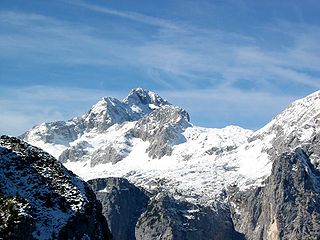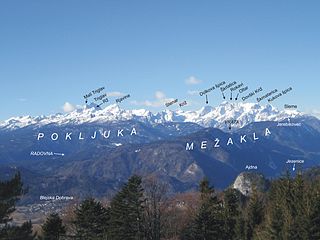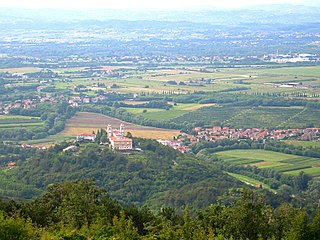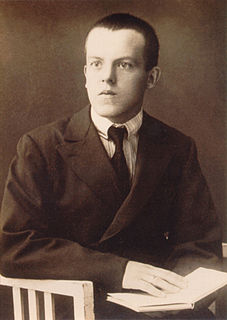
Slovenia is situated at the crossroads of central and southeast Europe, touching the Alps and bordering the Adriatic Sea. The Alps—including the Julian Alps, the Kamnik-Savinja Alps and the Karawank chain, as well as the Pohorje massif—dominate northern Slovenia along its long border to Austria. Slovenia's Adriatic coastline stretches approximately 47 km (29 mi) from Italy to Croatia. Its part south of Sava river belongs to Balkan peninsula – Balkans.

Carniola is a historical region that comprised parts of present-day Slovenia. Although as a whole it does not exist anymore, Slovenes living within the former borders of the region still tend to identify with its traditional parts Upper Carniola, Lower Carniola, and to a lesser degree with Inner Carniola. In 1991, 47% of the population of Slovenia lived within the borders of the former Duchy of Carniola.

Triglav, with an elevation of 2,863.65 metres (9,395.2 ft), is the highest mountain in Slovenia and the highest peak of the Julian Alps. The mountain is the pre-eminent symbol of the Slovene nation. It is the centrepiece of Triglav National Park, Slovenia's only national park. Triglav was also the highest peak in Yugoslavia before Slovenia's independence in 1991.

The Julian Alps are a mountain range of the Southern Limestone Alps that stretch from northeastern Italy to Slovenia, where they rise to 2,864 m at Mount Triglav, the highest peak in Slovenia and of the former Yugoslavia. A large part of the Julian Alps is included in Triglav National Park. The second highest peak of the range, the 2,755 m high Jôf di Montasio, lies in Italy.

Friuli is an area of Northeast Italy with its own particular cultural and historical identity containing 1,000,000 Friulians. It comprises the major part of the autonomous region Friuli Venezia Giulia, i.e. the administrative provinces of Udine, Pordenone, and Gorizia, excluding Trieste.

Nova Gorica (pronounced [ˈnɔ̀ːʋa ɡɔˈɾìːtsa]; is a town in western Slovenia, on the border with Italy. It is the seat of the Municipality of Nova Gorica. Nova Gorica is a planned town, built according to the principles of modernist architecture after 1947, when the Paris Peace Treaty established a new border between Yugoslavia and Italy, leaving nearby Gorizia outside the borders of Yugoslavia and thus cutting off the Soča Valley, the Vipava Valley, the Gorizia Hills and the northwestern Karst Plateau from their traditional regional urban centre. Since 1948, Nova Gorica has replaced Gorizia as the principal urban centre of the Gorizia region, as the northern part of the Slovenian Littoral has been traditionally called.

The Grossglockner is, at 3,798 metres above the Adriatic (12,461 ft), the highest mountain in Austria and the highest mountain in the Alps east of the Brenner Pass. It is part of the larger Glockner Group of the Hohe Tauern range, situated along the main ridge of the Central Eastern Alps and the Alpine divide. The Pasterze, Austria's most extended glacier, lies on the Grossglockner's eastern slope.

Edvard Rusjan was a Italo-Slovenian flight pioneer and airplane constructor. He died in an airplane crash in Belgrade.

Bovec is a town in the Littoral region in northwestern Slovenia, close to the border with Italy. It is the central settlement of the Municipality of Bovec.

Goriška is a historical region in western Slovenia on the border with Italy. It comprises the northern part of the wider traditional region of the Slovenian Littoral (Primorska). The name Goriška is an adjective referring to the city of Gorizia, its historical and cultural centre.

Eastern Alps is the name given to the eastern half of the Alps, usually defined as the area east of a line from Lake Constance and the Alpine Rhine valley up to the Splügen Pass at the Alpine divide and down the Liro River to Lake Como in the south. The peaks and mountain passes are lower than the Western Alps, while the range itself is broader and less arched.

The Princely County of Gorizia and Gradisca, historically sometimes shortened to and spelled "Goritz", was a crown land of the Habsburg dynasty within the Austrian Littoral on the Adriatic Sea, in what is now a multilingual border area of Italy and Slovenia. It was named for its two major urban centers, Gorizia and Gradisca d'Isonzo.

Julius Kugy was a mountaineer, writer, botanist, humanist, lawyer and officer of Slovenian descent. He wrote mostly in German. He is renowned for his travelogues from opening up the Julian Alps, in which he reflected on the relationship between man, nature, and culture. He opposed competing nationalist ideologies in the Alpe-Adria region, insisting on the need of peaceful co-existence among Slovene, Italian and German peoples.

Klement Jug was a Slovene philosopher, essayist and mountaineer who died while climbing Mount Triglav. Although he did not publish many works during his lifetime, he became one of the most influential thinkers of the younger generations of Slovenian intellectuals in the interwar period.

Anton Füster, also spelled as Fister was an Austrian Roman Catholic priest, theologian, pedagogue, radical political activist and author of Slovene origin. He was one of the leaders of the Viennese March Revolution of 1848.

The Hoher Göll is a 2,522 m (8,274 ft) mountain in the Berchtesgaden Alps. It is the highest peak of the Göll massif, which straddles the border between the German state of Bavaria and the Austrian state of Salzburg.

Aljaž Lodge in the Vrata Valley is a mountain hut that lies near the stream Triglav Bistrica in the upper end of the Vrata Valley. The hut is named after the Slovene priest and composer Jakob Aljaž (1845–1927), who in 1896 ordered the construction of the first wooden hut in the valley. The original Aljaž Lodge was built in 1904, and rebuilt in 1910 after the previous one was destroyed by an avalanche. Aljaž Lodge is the starting point to ascend the mountains Triglav, Škrlatica and Cmir.

The Triglav Lodge at Kredarica is the highest mountain hut in Slovenia and the highest meteorological station in the country. It stands on a small plateau just under the peak of Kredarica, an elevation in the ridge between Rjavina and Triglav. The Valentin Stanič Lodge stands to the northeast below Begunje Peak, and the Planika Lodge at Triglav stands to the south. In the vicinity there is also a chapel dedicated to Our Lady of the Snows, and a few metres away there is a small cave named Ivačič Cave.

Rjavina is a mountain in Slovenian Julian Alps. It rises 2,532 m (8,307 ft) above sea level. Located between two Alpine glacial valleys, Kot and Krma, it offers nice views to some of the highest Slovenian peaks, including Triglav, Škrlatica and Rž.




















